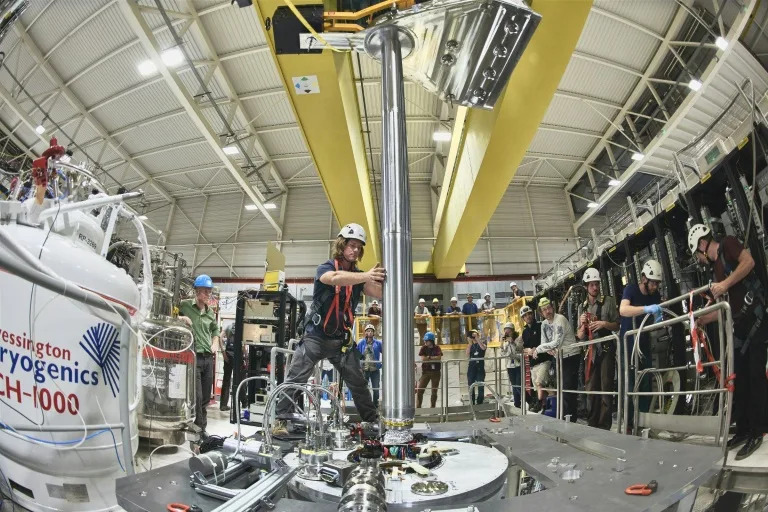
Scientists have detected antimatter particles – the mysterious sisters of the visible matter all around us – plummeting downwards due to gravity for the first time, Europe’s physics lab CERN said on Wednesday.
The experiment was hailed as a “huge milestone,” even though most scientists predicted the outcome, and it was predicted by Einstein’s 1915 theory of relativity.
It firmly rules out the possibility that gravity repels antimatter upwards, a result that would have fundamentally altered our understanding of the world.
There is almost no antimatter in the universe
The Big Bang is thought to have occurred some 13.8 billion years ago, producing an equal amount of matter – what everything visible is made of – and antimatter, its equal but opposing counterpart.
However, there is almost no antimatter in the universe, leading to one of physics’ greatest mysteries: what happened to all the antimatter?
“Half the universe is missing,” said Jeffrey Hangst, a member of CERN’s ALPHA collaboration in Geneva which conducted the new experiment.
“In principle, we could build a universe — everything that we know about — with only antimatter, and it would work in exactly the same way,” he told AFP.
One of the big unanswered concerns surrounding antimatter was whether gravity led it to descend like normal matter
Physicists believe that after the Big Bang, matter and antimatter collided and nearly destroyed each other.
Despite this, matter currently accounts for about 5% of the cosmos, with the remainder being even less understood dark matter and dark energy, while antimatter has vanished.
One of the big unanswered concerns surrounding antimatter was whether gravity led it to descend like normal matter.
While the majority of physicists believed it did, a few hypothesized otherwise.
A falling apple famously inspired Isaac Newton’s study on gravity, but would that apple have rocketed up into the sky if it was made of antimatter?
And if gravity did repel antimatter, it could have meant that hitherto unthinkable things like a perpetual motion machine were attainable.
“So why not drop some and see what happens?” Hangst said.
He linked the experiment to Galileo’s famous (16th-century) demonstration that two balls of differing masses dropped from the Leaning Tower of Pisa would fall at the same rate.
CERN scientists created the first antimatter atoms in 1996 – antihydrogen
However, this experiment, the outcome of 30 years of antimatter research at CERN, was “a little bit more involved” than Galileo’s, according to Hangst.
One issue was that antimatter only exists in the form of rare, short-lived particles in space.
However, in 1996, CERN scientists created the first antimatter atoms – antihydrogen.
Another difficulty was that, because matter and antimatter have opposing electrical charges when they collide, they destroy each other in a cataclysmic blast of energy known as annihilation.
The ALPHA team built a 25-centimeter (10-inch) bottle on its end with magnets at the top and bottom to explore gravity’s influence on antimatter.
Late last year, scientists inserted approximately 100 extremely cold antihydrogen atoms into this “magnetic trap” known as ALPHA-g.
The antihydrogen particles, which were bouncing around at 100 meters per second, were able to escape out either end of the bottle as they reduced the strength of both magnets
The experiment proves that gravity does not cause antihydrogen to rise
The scientists simply tallied the amount of antimatter destroyed at each end of the bottle.
Around 80% of the antihydrogen leaked from the bottom, which is comparable to how conventional bouncing hydrogen atoms would behave in the bottle.
This finding, published in the journal Nature, demonstrates that gravity forces antimatter to descend downward, just as Einstein predicted in his 1915 theory of relativity.
CERN scientists changed the strength of the magnets in more than a dozen tests, examining gravity’s influence on antimatter at different rates.
While the experiment proves that gravity does not cause antihydrogen to rise, Hangst emphasizes that it does not prove that antimatter behaves exactly like conventional matter.
“That’s our next task,” he explained.
It was “a huge milestone,” said Marco Gersabeck, a scientist who works at CERN but was not engaged in the ALPHA project.
However, he claims that it is “only the start of an era” of more exact observations of gravity’s effect on antimatter.
Using CERN‘s Large Hadron Collider to explore odd particles dubbed beauty quarks is another attempt to better comprehend antimatter.
In addition, an experiment on the International Space Station is attempting to capture antimatter in cosmic rays.
However, why the universe is overflowing with matter but devoid of antimatter “remains a mystery,” according to physicist Harry Cliff.


